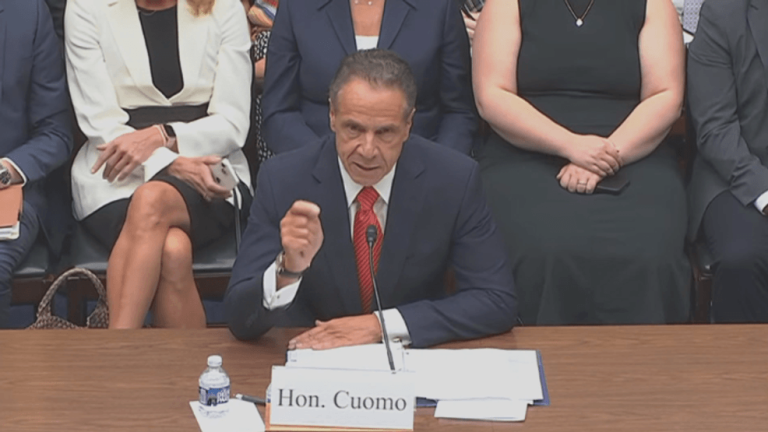Syracuse, New York — What began as a fact-finding mission on the pandemic by a Republican-led congressional subcommittee quickly turned into a political spat between the former New York state leader and Republican congressional leaders.
This week, the Subcommittee released a detailed 48-page document analyzing the impact of Governor Cuomo’s nursing home directive, issued on March 25, 2020. The directive prohibited nursing homes from refusing to admit patients solely because they had tested positive for COVID-19, leading to a surge of hospitalized COVID patients returning to nursing home beds. The directive was “superseded,” in Governor Cuomo’s preferred term, about six weeks later, repealing the requirement.
Critics blamed the order for thousands of nursing home deaths during the pandemic. Rosemary Morrissey lost her father, Lenny Beter, in April 2020 while the order was in effect. He was rushed from Grand Nursing Home to a hospital and put on a ventilator. Morrissey never got to speak to her father in person again.
“The way things are being handled is awful,” Morrissey said.
The subcommittee report revealed internal Cuomo administration documents that showed that facilities that complied with the directive and admitted COVID-19 positive patients had an 8.1% mortality rate, nearly double the 4.1% mortality rate in facilities that did not admit those types of patients. More than 9,000 transfers took place during the period the directive was in effect.
Bill Hammond, a health policy expert at the Empire Center think tank, has been following the issue closely since the pandemic began. Hammond said it was a mistake, but it would be disingenuous to blame all the nursing home deaths on a directive that began long after the coronavirus had started to spread in communities across the country and lasted six weeks. Still, Hammond explained that New York Governor Cuomo’s policy went far beyond what other states proposed at the time by adding legal language that nursing homes “must comply with.”
“While this order is not the only source of COVID-19 outbreaks in nursing homes, it has exacerbated an already deteriorating situation,” Hammond said.
He said that in politics, “a cover-up is worse than a crime,” and he thinks that’s a fair assessment of what got Cuomo into trouble Tuesday.The subcommittee report analyzed documents and testimony from the past three years and showed that Cuomo and his aides tried to downplay the severity of the 2020 nursing home crisis and shift the blame to his administration.
The report mirrors the findings of an investigation led by Democratic state Comptroller Thomas DiNapoli and Democratic state Attorney General Letitia James, which found that the New York State Department of Health undercounted nursing home deaths by about 50%.
In his testimony on Tuesday, former Governor Cuomo denied ever directing staff to conceal or manipulate the numbers.
“The numbers are far from solid and they’re very problematic because we were calling nursing homes in the middle of a pandemic and asking for forensic audits,” Gov. Cuomo said.
Governor Cuomo was quick to label the hearing as politically motivated and immediately went on the offensive, attacking former Republican President Donald Trump’s response to COVID-19 at the national level.
“I have vehemently opposed President Trump because from day one he has knowingly deceived the American people, denying the very real threat of COVID-19, saying it was like the flu, saying we could just use Clorox and it would be gone by Easter,” Cuomo said.
It was the start of a partisan attack that led to a heated exchange with North Country Rep. Elise Stefanik, who claimed without evidence that all of New York’s nursing home deaths were due to the directive, before moving on to questions about Governor Cuomo’s book deal.
The subcommittee has now issued a subpoena to Gov. Kathy Haukle, who succeeded Cuomo in 2021 when he resigned amid sexual harassment allegations, but the governor still denies the allegations. The subcommittee’s report found that Haukle and her office initially refused to provide basic documents about the COVID-19 response in nursing homes during his predecessor’s tenure, but Haukle’s team released thousands of documents that were largely redacted.
An independent investigation commissioned by Governor Hochrus in early 2024 concluded that the nursing home directive was implemented based on the “best available data” and therefore had “unintended consequences.”

